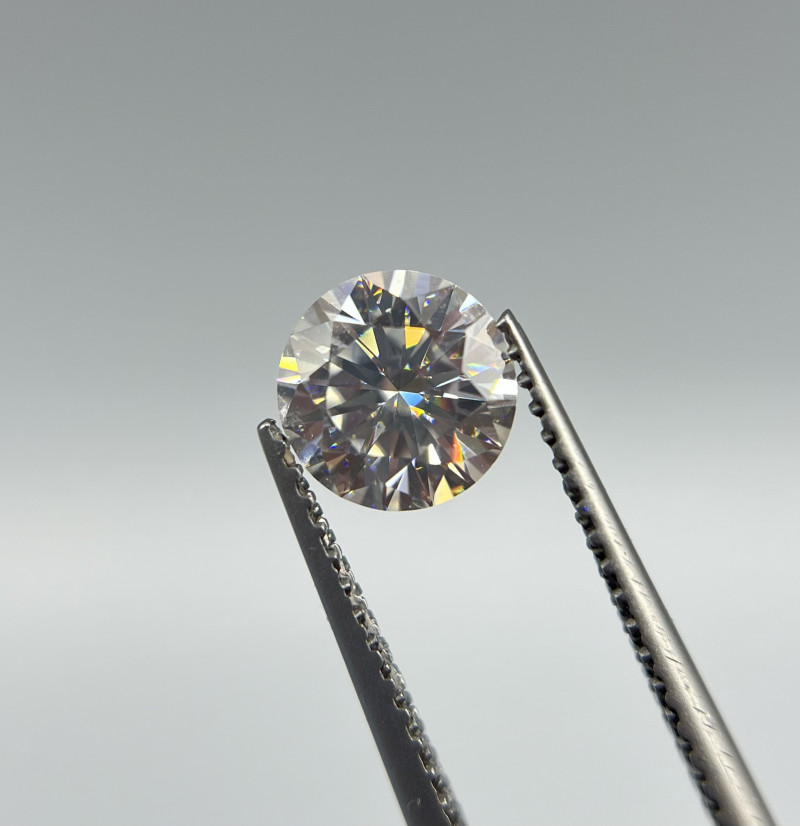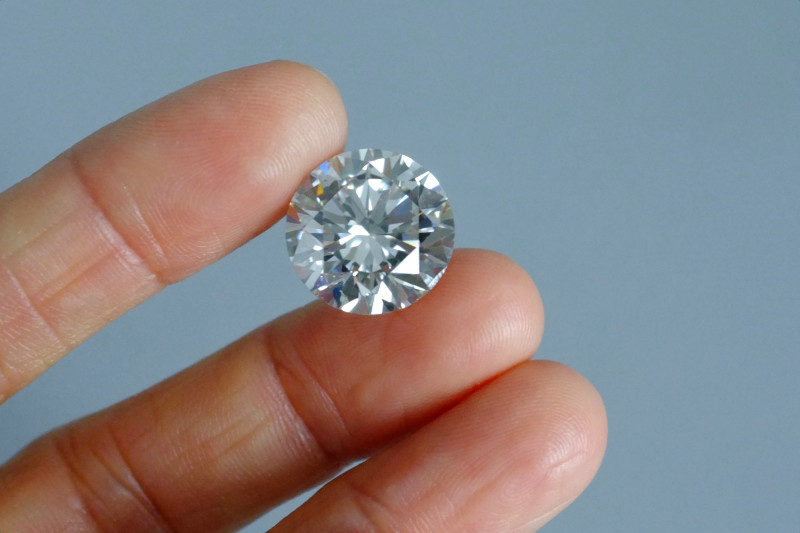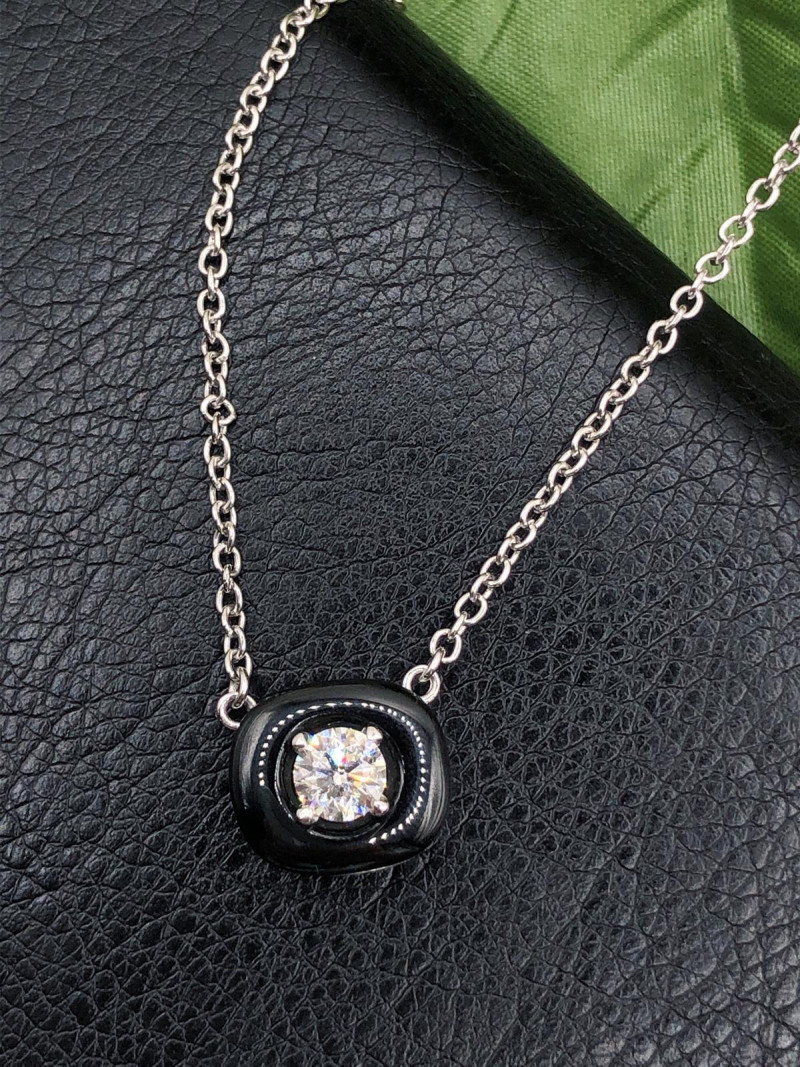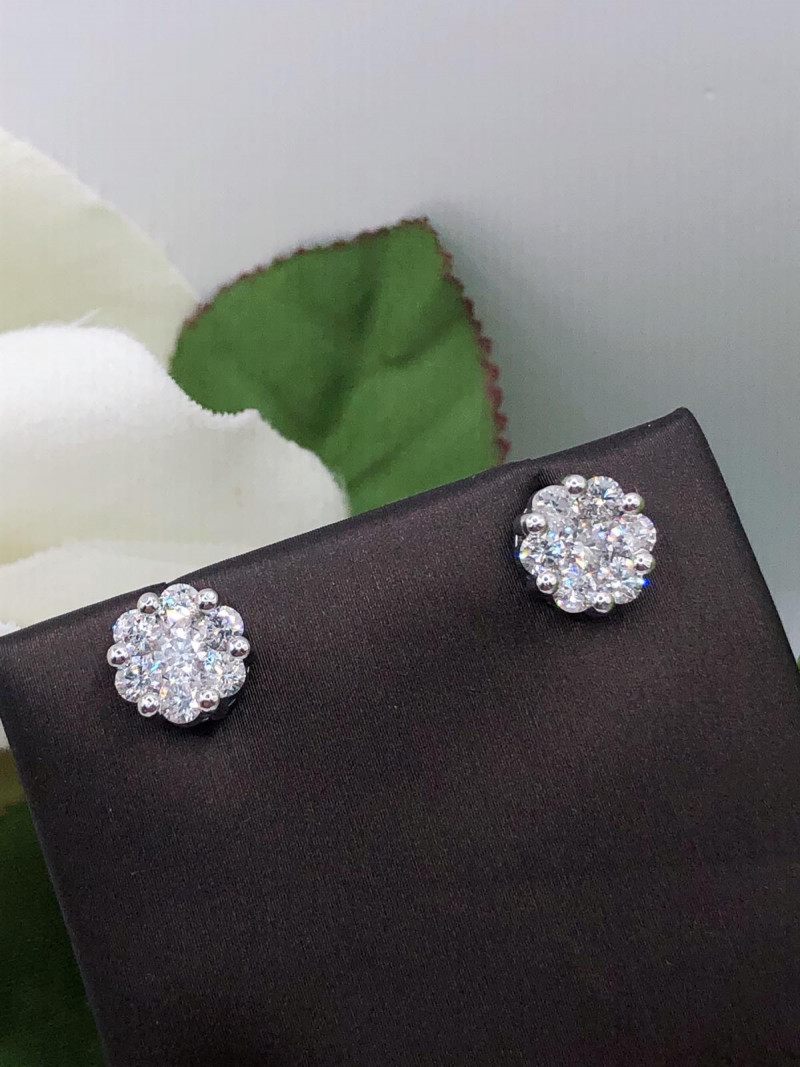
Was ist ein Moissanit-Diamant? Wert, Eigenschaften, Vor- und Nachteile
 Moissanit ist ein farbloser, transparenter Edelstein, der oft als Alternative zu Diamanten verwendet wird. Aus diesem Grund wird der Edelstein manchmal „Moissanit-Diamant“ genannt, obwohl es sich um einen völlig anderen Stein handelt.
Moissanit ist ein farbloser, transparenter Edelstein, der oft als Alternative zu Diamanten verwendet wird. Aus diesem Grund wird der Edelstein manchmal „Moissanit-Diamant“ genannt, obwohl es sich um einen völlig anderen Stein handelt.
Obwohl es natürlich vorkommenden Moissanit gibt, sind praktisch alle heute erhältlichen Moissanit-Edelsteine synthetisch (im Labor hergestellt).
Es gibt viele Alternativen zu Diamanten, sei es für Verlobungsringe oder anderen Diamantschmuck. Einige Beispiele sind Zirkonia, Zirkonia und Saphir. In den letzten Jahren ist Moissanit als eine der besten Diamantalternativen aufgestiegen.
Aber was ist Moissanit? Woher kommt es und wie lässt es sich mit Diamanten vergleichen? Wir beantworten alle Ihre Fragen in diesem Moissanit-Leitfaden!

Was ist Moissanit?
Moissanit ist ein Siliziumkarbidmineral, das erstmals in einem Meteoritenkrater in Arizona, USA, entdeckt wurde. Natürlicher Moissanit ist unglaublich selten und wurde bisher nur in Meteoriten und gelegentlich im oberen Erdmantel gefunden.
Aufgrund seiner Seltenheit hat sich der Markt synthetischem Moissanit zugewandt.
Andere Begriffe für „synthetisch“ sind künstlich hergestellt, im Labor gezüchtet und im Labor erzeugt. Synthetischer Moissanit wird wie jeder synthetische Edelstein im Labor hergestellt, besitzt aber die gleichen physikalischen und chemischen Eigenschaften wie natürlicher Moissanit.
Wie wird Moissanit hergestellt?
Der Entstehungsprozess von natürlichem Moissanit ist etwas unklar, da viele Steine auf Meteoriten auf die Erde gelangten. Wissenschaftler glauben jedoch, dass er wahrscheinlich unter großer Hitze und hohem Druck entsteht, sodass diese Bedingungen häufig nachgeahmt werden, um synthetischen Moissanit herzustellen.
Zwar gibt es von Labor zu Labor unterschiedliche Methoden, eine der gebräuchlichsten ist jedoch das Lely-Verfahren.
Das Lely-Verfahren für synthetisches Moissanit beginnt mit Siliziumkarbidpulver. Dieses Pulver wird in einen Graphittiegel gegeben, ein Behälter zum Erhitzen oder Schmelzen von Materialien wie Metallen.
Von dort entfernen sie Sauerstoff und alle anderen Dämpfe oder Gase mit Argongas. Dann erhitzen sie den Tiegel auf etwa 2.500 °C (4.530 °F). Das Siliziumkarbid verwandelt sich in Dampf, der sich auf einem zentralen Graphitstab ablagert und allmählich zu einem Kristall abkühlt.
Obwohl die Herstellung im Laufe der Zeit perfektioniert wurde, dauert die Herstellung eines Edelsteins im Allgemeinen immer noch 1–2 Monate. Zu den namhaften Herstellern zählen Charles and Colvard, Amora Gems und Harro Gems.
Welche Eigenschaften hat der fertige Moissanit?
Oben abgebildet: Synthetischer Moissanitkristall | Bildnachweis: Lamiot; Creative Commons Attribution-Share Alike 4.0 International-Lizenz
Eigenschaften des Moissanit-Minerals
Moissanit besteht aus Siliziumkarbid und hat die Formel SiC. Siliziumkarbid oder „Karborund“ hat eine Reihe von industriellen Anwendungen, einige davon im Schmucksektor. Vor allem wird Karborund als Halbleiter und Schleifmittel verwendet, kommt aber selten in der Natur vor – ein Rätsel, das in die Geschichte von Moissanit hineinspielt.
Am bekanntesten ist die farblose Form, doch Moissanit kann auch in der Natur in Gelb, Schwarz oder Grün vorkommen. Synthetischer Moissanit kann praktisch jede Farbe haben.
Hier sind die anderen Eigenschaften des Moissanit-Minerals:
Kristallstruktur : Hexagonal
Glanz : Diamantartig bis metallisch
Transparenz : Transparent
Brechungsindex : 2,59-2,69
Dichte : 3,21-3,22
Dekolleté : Undeutlich auf [0001]
Bruch : muschelförmig
Strich : Grünlich-grau
Lumineszenz : Manchmal schwache oder mäßige Fluoreszenz; Orange im LW-UV und selten im SW-UV; Thermolumineszenz (durch Hitze induziert);
Pleochroismus : Schwach; Hellblau bis sehr hellblau oder Indigo
Abgesehen von der Mineralogie: Woher stammt Moissanit?
Geschichte des Moissanit
Der französische Chemiker Dr. Henri Moissan entdeckte Moissanit erstmals im Jahr 1893. Auf der Suche nach einem Kristall für die industrielle Nutzung landete er im Canyon Diablo in Arizona, USA, wo er in einem alten Meteoritenkrater winzige Steine fand, die er für Diamanten hielt.
Zur gleichen Zeit, im Jahr 1890, versuchte der amerikanische Chemiker Edward Acheson synthetische Diamanten herzustellen, wobei er versehentlich Siliziumkarbid produzierte, das er „Carborund“ nannte. Dieser Prozess wurde zum „Acheson-Prozess“.
Im Jahr 1904 erkannte Moissan, dass es sich bei seinen Proben um natürliches Siliziumkarbid handelte. Der Tiffany-Gemmologe George Kunz benannte den Stein 1905 nach Moissan „Moissanit“.
Die ersten nicht-meteorischen Quellen für natürlichen Moissanit wurden in den 1950er Jahren in Felsen in Wyoming (USA) und Jakutien (Russland) entdeckt.
Seit 1987 ist Cree Research, Inc. in North Carolina ein Pionier in der Massenproduktion von synthetischem Moissanit.
Seit wann ist Moissanit auf dem Markt? Moissanit ist seit 1995 für die breite Masse erhältlich, als die Firma C3, Inc. (jetzt Charles & Colvard) erstmals synthetischen Moissanit kommerziell verfügbar machte.
Synthetische Moissanit-Edelsteine tauchten jedoch erstmals um 1980 auf. Jahrelang kannten nur Juweliere und Sammler Moissanit. Viele entschieden sich, es nicht zu vermarkten oder zu verkaufen, da es ihrem Verkaufsschlager, den Diamanten, Konkurrenz machen würde.
Einer Studie von The Knot aus dem Jahr 2021 zufolge ist Moissanit nach dem Diamanten der zweitbeliebteste Edelstein für Verlobungsringe und hat im Vergleich zu 2019 gegenüber dem Vorjahr um 9 Prozent zugenommen.
Aber wie schneiden Moissanite und Diamanten im Vergleich ab?
 Oben abgebildet: weißer Moissanit-Edelstein
Oben abgebildet: weißer Moissanit-Edelstein
 Oben abgebildet: weißer Diamant-Edelstein
Oben abgebildet: weißer Diamant-Edelstein
Moissanit vs. Diamant
Wenn Sie einen Moissanit und einen Diamanten nebeneinander betrachten, scheinen sie möglicherweise nicht zu unterscheiden.
Können Sie den Unterschied zwischen Diamant und Moissanit erkennen? Nur wenn Sie ein ausgebildeter Experte mit den richtigen Werkzeugen sind. Selbst mit einem Standard-Diamantprüfstift wird Moissanit oft als Diamant durchgehen.
Was sind also die Unterschiede zwischen Moissanit und Diamant?
Farbe & Reinheit
Moissanit ist wie Diamant traditionell farblos, weist aber oft gelbe bis braune Untertöne auf. Beide Steine können behandelt werden, um offensichtliche Untertöne zu entfernen.
Farbloser Moissanit kann bei natürlichem Licht etwas blau oder grün erscheinen. Betrachten Sie ihn daher vor dem Kauf immer unter verschiedenen Lichtquellen.
Moissanite und Diamanten sind in praktisch jeder Farbe erhältlich, wobei die helleren Farben von Moissanit größtenteils auf Behandlungen zurückzuführen sind. Die wertvollsten Moissanite sind jedoch die farblosesten.
Hinsichtlich der Reinheit werden Diamanten und Moissanite anhand ähnlicher Reinheitsskalen bewertet, wobei ihre Einstufung von den sichtbaren Einschlüssen abhängt.
Aufgrund des raffinierten Herstellungsverfahrens für Moissanit weisen die meisten Exemplare eine hohe Reinheit auf. Natürliche Diamanten mit der gleichen Reinheit sind dagegen seltener und teurer.
Und hier noch eine interessante Tatsache: Moissanit wurde als Einschluss in Diamanten gefunden!
Funkeln
Während der richtige Schliff für maximales Funkeln sorgen kann, spielen auch die physikalischen Eigenschaften eines Edelsteins eine Rolle.
Brillanz ist das weiße Licht, das vom Inneren des Steins reflektiert wird. Ein höherer Brechungsindex bedeutet höhere Brillanz, und Moissanit liegt mit einem Brechungsindex von 2,59-2,69 (im Vergleich zu Diamanten mit 2,41-2,42) an der Spitze.
Dispersion oder Feuer ist die Menge an buntem Licht, die ein Edelstein reflektiert. Die Dispersion von Moissanit beträgt 0,104 und ist damit mehr als doppelt so hoch wie das Feuer von Diamanten mit 0,044!
Ein weiterer zu berücksichtigender Faktor ist die Doppelbrechung . Einige Steine haben zwei Brechungsindizes, was zu Pleochroismus führt. Moissanit ist doppelbrechend, Diamant hingegen nicht.
Ein wichtiger Aspekt von Moissanit, den Sie im Hinterkopf behalten sollten, ist sein „Diskokugel“-Effekt . Manche Käufer empfinden sein regenbogenartiges Funkeln als zu auffällig oder kitschig, während andere behaupten, dass es ihnen mehr Komplimente einbringt, als sie für ihre Diamantringe bekommen haben.
Haltbarkeit
Sie wissen wahrscheinlich, dass Diamanten die härtesten Edelsteine sind und auf der Mohs-Härteskala für Mineralien den Härtegrad 10 erreichen. Aber ist Moissanit haltbar? Ja!
Mit einer Härte von 9,25 bis 9,5 liegt Moissanit knapp unter dem Diamanten – höher als der von Rubinen und Saphiren !
Allerdings ist Härte nur eine Art Kratzfestigkeit.
Zähigkeit ist die Widerstandsfähigkeit eines Edelsteins gegen Zerbrechen oder Absplittern. Diamanten haben eine spröde Zähigkeit, während Moissanite eine ausgezeichnete Zähigkeit aufweisen.
Die Spaltbarkeit beschreibt, wie leicht ein Edelstein entlang bestimmter Achsen (Spaltflächen) gespalten wird. Eine perfekte Spaltbarkeit ist am leichtesten zu spalten, und Diamanten haben eine perfekte Spaltbarkeit in 4 Richtungen, was sie anfällig für Spalten oder sogar Zersplittern macht, wenn sie in einem dieser 4 Winkel getroffen werden.
Im Gegensatz dazu weist Moissanit in einer Richtung eine undeutliche Spaltbarkeit auf (ist schwerer zu spalten), wodurch er weniger bruchanfällig ist.
Natürlich müssen wir auch andere Schadensarten berücksichtigen.
Ethik
Obwohl sowohl natürliche als auch synthetische Edelsteine ihre Vorteile haben, liegt ein Vorteil der synthetischen Edelsteine darin, dass bei ihrer Gewinnung keine schädlichen Auswirkungen auf die Umwelt auftreten und die oft unethischen Arbeitspraktiken beim Abbau vermieden werden.
Allerdings ist die Lage nicht ganz so eindeutig. Die Bedingungen in Minen, insbesondere in großen, können manchmal gefährlich sein, doch für viele Menschen in Entwicklungsländern ist der Bergbau eine feste Einnahmequelle. Außerdem bietet die Bergbauindustrie eine staatliche Finanzierungsquelle für dringend benötigte Entwicklungen.
Daher sind im Labor hergestellte Edelsteine nicht 100 Prozent ethischer als natürliche Edelsteine. Um diesen Bergbaugemeinden zu helfen, ein ethisches Ergebnis zu erzielen, bedarf es einer groß angelegten Branchentransformation – und nicht nur einer Umstellung auf eine neue Produktionsart.
Sie können Ihren Teil dazu beitragen, indem Sie einen Lieferanten wählen, dessen Bergbau ethisch einwandfrei ist. Das bedeutet sichere Arbeitsbedingungen, minimale Umweltbelastung und faire Löhne.
Eine umfassendere Aufschlüsselung dieser Unterschiede finden Sie in unserem Leitfaden zum Thema Moissanit vs. Diamanten .
Ein Unterschied, den wir oben nicht erwähnt haben, ist der Preis.

Moissanit Preis & Wert
Erstens: Ist Moissanit teurer als Diamant? Nein, ganz im Gegenteil. Moissanite kosten im Allgemeinen 10 Prozent von Diamanten gleicher Qualität.
Sind Moissanit-„Diamanten“ überhaupt etwas wert? Auf jeden Fall. Moissanite sind nicht so erschwinglich wie einige Diamantalternativen wie Zirkonia, aber Moissanit ist haltbarer als andere Alternativen.
Vergleichen wir einen 1-karätigen, farblosen Moissanit im Rundschliff mit einem Diamanten. Dieser Diamantentyp bringt 2.000 bis 25.000 US-Dollar ein, während dieser Moissanit-Typ für etwa 450 bis 600 US-Dollar zu haben ist.
Sie interessieren sich für eine farbenfrohere Option? Der Großhandelspreis für farbige Moissanite ist mit 10 bis 80 US-Dollar für 1-Karat-Steine sogar noch niedriger. Moissanitringe mit 0,5 bis 1 Karat kosten im Großhandelspreis 35 bis 90 US-Dollar und insgesamt weniger als 250 US-Dollar.
Und was ist mit synthetischen Diamanten ? Der Durchschnittspreis für einen 1-Karat-Diamanten liegt zwischen 800 und 1.000 US-Dollar pro Karat – also deutlich höher als bei synthetischem Moissanit.
Wo kann ich Moissanit kaufen?
Ein Problem von Moissanit, insbesondere im Vergleich zu Diamanten, ist die begrenzte Verfügbarkeit. Diamanten sind bei fast jedem Schmuckhändler erhältlich, bei Moissanit ist das jedoch nicht der Fall.
Da das Wissen über Moissanit zugenommen hat, bieten immer mehr Einzelhändler wie Kohl's und Amazon es an. Das Hauptproblem ist der persönliche Einkauf; es kann schwierig sein, Moissanite in physischen Geschäften zu finden.
Natürlich gibt es beim Online-Shopping im Vergleich zum Einkaufen im Geschäft Vor- und Nachteile.
Laut Richline Digital kaufen etwa 90 Prozent der Paare ihre Verlobungsringe persönlich, doch im Geschäft sind die Kosten für Diamanten im Allgemeinen 40 bis 50 Prozent höher als online.
Ein großer Nachteil beim Online-Shopping besteht darin, dass man die Sachen nicht anprobieren und bei unterschiedlichen Lichtverhältnissen betrachten kann.
Letztendlich ist es eine Frage der persönlichen Präferenz.
Lassen Sie uns nun einige der vielen aufregenden Möglichkeiten besprechen, wie Sie Moissanit tragen können!
Arten von Moissanit-Schmuck
Die Haltbarkeit, der erschwingliche Preis und die Vielseitigkeit von Moissanit eignen sich für alle Arten von Schmuck, darunter:

Ringe
Es überrascht nicht, dass dieser Edelstein üblicherweise mit einem Moissanit-„Diamant“-Ring getragen wird, egal, ob es sich um einen Verlobungsring ohne Diamanten handelt oder nicht.
Moissanite können in jede beliebige Form geschliffen werden und da sie keine perfekte Spaltbarkeit aufweisen, ist praktisch jede Fassung geeignet – Lünetten- , Korb- oder Krappenfassung , was auch immer Sie wollen.
Außerdem können Sie das Geld, das Sie durch die Entscheidung für Moissanit gespart haben, für einen kunstvollen Pavé- , Halo- oder sogar Doppel-Halo- Stil ausgeben.

Anhänger & Halsketten
Eine weitere beliebte Wahl für Moissanitschmuck ist eine Halskette mit Anhänger. Die klassischste Wahl ist eine Solitärkette mit einem einzelnen Moissanit. Aber Sie können mit dem Design alles Mögliche machen, von einer ganzen Kette aus Moissaniten bis hin zu einzigartigen Moissanit-Hip-Hop-Halsketten.

Armbänder & Uhren
Moissanit-Armbänder reichen von glamourösen Moissanit-Tennisarmbändern bis hin zu minimalistischen Moissanit-Schiebearmbändern mit einem einzigen Moissanit. Ein mit Moissanit besetztes Manschettenarmband ist ein weiterer klassischer, faszinierender Stil.
Beliebte Stile für Männer sind kubanische Gliederarmbänder aus Weißgold mit Moissanit oder mit Moissanit besetzte Uhren.

Ohrringe
Wie die oben genannten Schmuckarten haben Moissanit-Ohrringe viel Potenzial. Natürlich sind Moissanit-Ohrstecker der Standard. Aber andere Stile wie mit Moissanit besetzte Creolen, Kronleuchter- oder Crawler-Ohrringe reflektieren Regenbögen aus jedem Winkel.
Unabhängig vom Stil ist die Pflege von Moissanit entscheidend, damit er seinen hellen Glanz behält (man könnte sagen, wie ein Diamant).
Reinigung und Pflege von Moissanit-Schmuck
Glücklicherweise verblassen die Farbe und Reinheit von Moissanit nicht. Eventuelle Mattheiten können durch Reinigen behoben werden.
So reinigen Sie Moissanit:
Mischen Sie in einer Schüssel warmes Wasser mit einem milden Flüssigwaschmittel.
Tauchen Sie eine weiche Bürste (z. B. Zahnbürste) in die Mischung.
Schrubben Sie den Moissanit sanft mit der Bürste.
Spülen Sie den Stein gründlich mit lauwarmem Wasser ab.
Trocknen Sie es mit einem Föhn, einem Behälter mit Reis oder einem Mikrofasertuch.
Sie können Moissanit unter der Dusche tragen, die entstehenden Seifenablagerungen können jedoch eine häufigere Reinigung erforderlich machen.
Ruiniert Chlor Moissanit? Schwimmen hat keine Auswirkungen auf Moissanit, Chlor kann jedoch Metallfassungen beeinträchtigen.

Bereit, Moissanit zu bestaunen?
Moissanit ist sicherlich eine erstklassige Alternative zu Diamanten, aber er hat noch viel mehr zu bieten. Dieser Edelstein bietet ein Funkeln und einen Glanz, der ein Leben lang hält, und Sie können mit diesem im Labor hergestellten Stein eine nachhaltige Wahl treffen.
Bereit zum Einkaufen? Stöbern Sie noch heute durch unsere Kollektion von Moissanit-Schmuck!
Suche nach Fashion Encyclopedia
Verwandte Auktionen
In Verbindung stehende Artikel
Eine einfache Anleitung zum Verständnis der Goldpunzen, ihrer Identifizierung und den Methoden zur Prüfung der Goldreinheit.
13th Jun 2019
Schmuckwerkzeuge für Bastler, von der Drahtwicklung bis zur Fassung von Edelsteinen
11th Feb 2016
Keuschheitsringe sind eine Art Ring, der die Verpflichtung zur sexuellen Abstinenz bis zur Ehe symbolisiert. Dieser Leitfaden erläutert die Geschichte hinter Keuschheitsringen sowie ihre Bedeutungen, Regeln und Stile.
20th Mar 2019
Neue Artikel
Titan ist ein beliebtes Schmuckmetall, das für sein geringes Gewicht, seine Langlebigkeit und seinen günstigen Preis bekannt ist. Erfahren Sie alles über Titan, wie es im Vergleich zu ähnlichen Metallen abschneidet und welche Vor- und Nachteile Titanschmuck hat.
7th Feb 2023
Erfahren Sie alles über Wolframschmuck – von seiner Geschichte und Verwendung bis hin zu seiner Haltbarkeit und Pflege. Am Ende unseres Leitfadens wissen Sie, ob Wolfram das Richtige für Sie ist!
7th Feb 2023
Sie möchten Ihre Sammlung edler Accessoires um zeitlosen Weißgoldschmuck ergänzen? Hier erfahren Sie alles Wissenswerte über edles Weißgold!
29th Jan 2023




